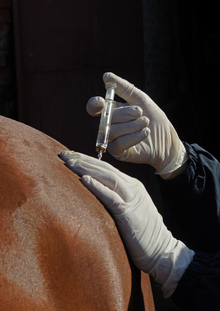In their spring bulletin, My Horse University eXtension service shares the latest information about core vaccinations and infectious disease control for horses. Written by Fernanda Camargo-Stutzman and Kristen Harvey, of the Department of Animal Sciences University of Kentucky Cooperative Extension Service, this information serves as an important guide for all horse owners.

Horse receiving a vaccination
The spread of infectious diseases tends to increase at sales or boarding facilities, breeding farms, barns of performance and show horses, fairgrounds or racetracks where situations are ideal for introducing and transmitting infectious diseases.
© 2015 by Kondrashov MIkhail Evgenevich
Programs for the control of infectious diseases are important components of good management practices directed toward maximizing the health, productivity and performance of horses. Infectious diseases occur when horses are exposed to a sufficient quantity of an infectious agent that it overcomes the horses' previously acquired resistance.
Some of the goals of disease control programs include the reduction of factors that may decrease resistance or increase susceptibility of disease in the horse.
Such factors include stress, overcrowding, parasitism, poor nutrition, inadequate sanitation, contaminated water source/supply, concurrent disease, stringent exercise program, no turn-out time, transportation, inclement weather, weaning, disruption of established social groups, and movement of people, vehicles, and/or equipment on and off facilities during infectious disease outbreaks.
Consistent utilization of good management programs will lower the incidence and/or severity of infectious diseases in any particular herd.
A well-delineated vaccination program can also enhance resistance to those diseases; however, vaccines can protect horses from some but not all infectious diseases. A horse or groups of horses that are well-fed and well-managed are most likely to maintain good health.
The occurrence of infectious diseases tends to increase at sales or boarding facilities, breeding farms, barns of performance and show horses, fairgrounds or racetracks. Such situations are ideal for introducing and transmitting infectious diseases, particularly infections of the respiratory tract.
In farms where there is a resident herd and an itinerant herd, the management of the two distinct populations needs to be taken into account. The introduction of horses from various backgrounds and origins and the commingling of horses of different ages, career/use and traveling status create special problems and need to be specifically addressed in the practice of disease control.
Management recommendations are based on the practices of (1) segregation of horses on the premises into small groups, (2) the maintenance of each horse group as an isolated unit, and (3) stress reduction.
Horses should be segregated into groups that are similar in age, gestation status, use and frequency of removal of individual animals. Restrictions should be placed on movement of horses into and out of each established group, and contact with transient horses in particular should be avoided.
The greatest danger lies in the introduction of new horses into established groups, especially those with recent opportunities for exposure to large, intermingled gatherings of horses from diverse sources (sales, shows, boarding stables, racetracks, competitions, training centers, etc.).
Ideally, horses should be appropriately vaccinated at least one month prior to entering or leaving such a facility in order to produce adequate antibodies before the anticipated exposure.
Ideally, before a new horse is introduced into a closed group, it should be isolated for 21 days. In addition, a horse temporarily removed from a group for prolonged transport or contact with other horses (e.g., breeding, showing, training, veterinary care, sales, etc.) should also undergo a 21-day isolation period and evaluation for signs of infection before being returned to its resident group.
In cases of respiratory and digestive system diseases, infection often spreads rapidly, resulting in significant economic impact. Immediate intervention with infectious disease control measures is required for successful containment of the infection.
Implementing the practices of isolation, quarantine and disinfection is imperative for managing an outbreak. Clinically ill horses should be removed from their resident group and kept in physical isolation away from the remainder of the horse population.
A zone of empty space sufficient to serve as a barrier should surround the isolation area. Human and horse traffic through the isolation area should be restricted. Personnel caring for horses placed in isolation should wear protective outer clothing, disposable latex gloves and footwear that can be immersed in a disinfectant footbath.
All of the outer protective clothes should be removed upon leaving the isolation area. Ideally, staff members handling horses in isolation would be assigned to that group only. Remember to thoroughly clean and disinfect the area used as isolation facilities after resolution of the disease.
Vaccination
Vaccination is also an important part of infectious disease control.
The American Association of Equine Practitioners (AAEP) and the American Veterinary Medical Association (AVMA) divide their vaccination program into two categories: core and risk-based vaccination guidelines.
The AVMA defines core vaccinations as those âthat protect from diseases that are endemic to a region, those with potential public health significance, required by law, virulent/highly infectious, and/or those posing a risk of severe disease.â
It is recommended that all horses receive the vaccinations included in this group. Diseases included in the core list are tetanus, rabies, eastern and western equine encephalomyelitis and West Nile virus. Diseases included in the risk-based list vary regionally, from population to population within an area or even between individual horses within a population.
Diseases included in the risk-based list are anthrax, botulism, equine herpesvirus (rhinopneumonitis), equine viral arteritis, equine influenza, Potomac horse fever, rotaviral diarrhea and strangles. It is important to consult your veterinarian to develop a vaccination protocol for your horse population. This publication will focus on the core vaccination guidelines.
By Fernanda Camargo-Stutzman and Kristen Harvey, Department of Animal Sciences, University of Kentucky Cooperative Extension Service
Read their complete list of Core Vaccinations necessary for horse health.
